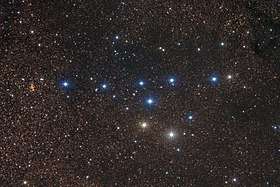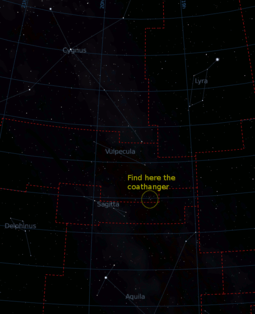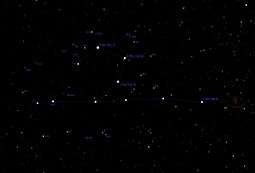Brocchi's Cluster
Brocchi's Cluster (also known as Collinder 399, Cr 399 or Al Sufi's Cluster) is a random grouping of stars located in the constellation Vulpecula near the border with Sagitta. The members of the star cluster form an asterism which has given rise to its name as the Coathanger.
 Amateur image of an asterism Collinder 399 and surroundings | |
| Object type | Asterism |
|---|---|
| Other designations | OCl 113, OCl 113.0, C 1923+200 |
Observation data (Epoch J2000.0) | |
| Constellation | Vulpecula |
| 19h 25m 24s | |
| Declination | 20° 11′ 00″ |
In visual light (V) | |
| 3.6 | |
Size | ~60' |
History
It was first described by the Persian astronomer Al Sufi in his Book of Fixed Stars in 964.
In the 17th century, it was independently rediscovered by the Italian astronomer G. B. Hodierna.
In the 1920s, Dalmero Francis Brocchi, an amateur astronomer and chart maker for the American Association of Variable Star Observers (AAVSO), created a map of this object for use in calibrating photometers.
In 1931, Swedish astronomer Per Collinder listed it in his catalogue of open clusters.[1]
Status
The status of this group as a star cluster has changed in recent years. The group was considered to be a cluster for most of the 20th century. Looking at a variety of criteria, however, a study in 1970 concluded that only 6 of the brightest stars formed an actual cluster. Several independent studies since 1998 have now determined that this object is not a true cluster at all, but rather just a chance alignment of stars. These recent studies have generally based their findings on improved measurements of parallax and proper motion provided by the Hipparcos satellite which were first published in 1997.[2]
The "Coathanger"


The asterism is made up of 10 stars ranging from 5th to 7th magnitude which form the conspicuous "coathanger", a straight line of 6 stars with a "hook" of 4 stars on the south side. An additional 30 or so fainter stars are sometimes considered to be associated as well.
Under a dark sky, the Coathanger can be seen with the naked eye as an unresolved patch of light; binoculars or a telescope at very low power are usually needed in order to view the "coathanger" asterism. It is best found by slowly sweeping across the Milky Way along an imaginary line from the bright star Altair toward the even brighter star Vega. About one third of the way toward Vega, the Coathanger should be spotted easily against a darker region of the Milky Way. The asterism is best seen in July–August and north of 20° north latitude it is displayed upside down (as in the picture top right of this page) when it is at its highest point. South of this latitude it is shown upright as the 'hanger' is south of the line of 6 stars.
The asterism and its immediate surroundings are a useful gauge for determining the faintest stars visible in a small telescope as there are a wide range of stellar magnitudes within the cluster easily viewed in one small location of the sky.
The following is a list of the 10 stars commonly included as members of the Coathanger, organized by right ascension. They vary widely in distance, with only HD 182422, HD 183261, and 7 Vul being possibly remotely near each other.
At 7 Vul and HD 183261's closest possible distance to each other (1100 light-years), they would be further than 6 light-years apart from one another. At the closest possible distance of all three (1180 light-years), HD 182422 and HD 183261 would be separated by almost 20 light-years, and HD 182422 and 7 Vul would be separated by more than 25. For comparison, the Sun and the closest known star, Proxima Centauri, are slightly more than 4 light-years apart.
| Name | Apparent magnitude (V) |
Spectral type | Distance (LY) |
|---|---|---|---|
| HD 182293 | 7.111 | K3IVp | 354+12 −11 |
| HD 182422 | 6.398 | B9.5V | 1200+307 −203 |
| HD 182620 | 7.166 | A2V | 580+38 −34 |
| HD 182761 | 6.303 | A0V | 409+42 −35 |
| 4 Vul | 5.16 | K0III | 271.6+7.4 −7.0 |
| 5 Vul | 5.594 | A0V | 237.7+6.0 −5.7 |
| HD 182955 | 5.87 | M0III | 613+41 −36 |
| HD 182972 | 6.629 | A1V | 1354+295 −205 |
| HD 183261 | 6.875 | B3II | 2237+1589 −656 |
| 7 Vul | 6.327 | B5Vn | 1160+240 −170 |
References
- Collinder, Per (1931). "On Structural Properties of Open Galactic Clusters and their Spatial Distribution. Catalog of Open Galactic Clusters". Annals of the Observatory of Lund. 2: B1–B46. Bibcode:1931AnLun...2....1C.
- Baumgardt, H. (1998). "The nature of some doubtful open clusters as revealed by HIPPARCOS". Astronomy and Astrophysics. 340: 402–414. Bibcode:1998A&A...340..402B.
- Cragin, Murray; Lucyk, James; & Rappaport, Barry (1993). The Deep Sky Field Guide to Uranometria 2000.0 (1st ed). Richmond, VA: Willmann-Bell. ISBN 0-943396-38-7
- Dias, W.S.; Lépine, J.R.D.; & Alessi, B.S. (2001). "Proper motions of open clusters within 1 kpc based on the TYCHO2 Catalogue". Astronomy and Astrophysics 376, 441-447
- Hall, D.S. & VanLandingham, F.G. (1970). "The Nearby Poor Cluster Collinder 399". Pub. of the Astronomical Society of the Pacific 82 (487), p. 640-652
- Skiff, Brian (January, 1998). "Brocchi's Cluster Revealed". Sky and Telescope, p. 65-67
External links
- Brocchi's Cluster, Collinder 399 - SEDS
- NASA Astronomy Picture of the Day: Collinder 399: The Coat Hanger (12 January 2007)
- NASA Astronomy Picture of the Day: Collinder 399: The Coat Hanger (23 December 2008)
- Collinder 399: The Coat Hanger - LRGB CCD image
| Wikimedia Commons has media related to Coathanger Cluster. |